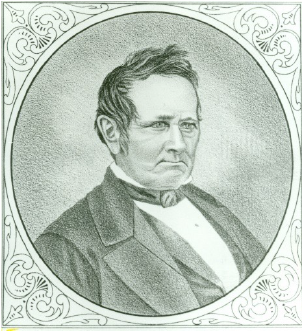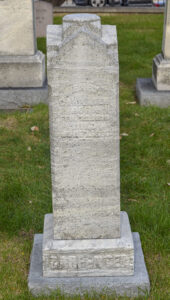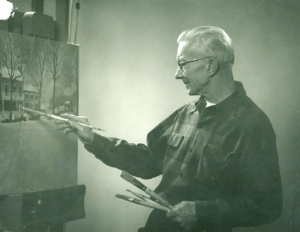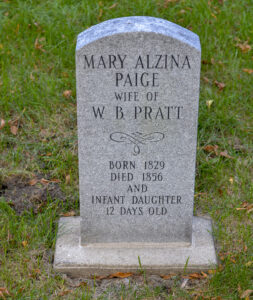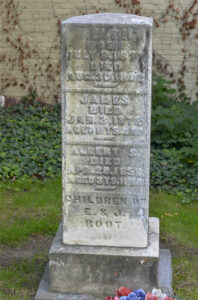Henry Carpenter was an early pioneer arriving in Downers Grove in 1939. He opened the first general store in the area, served the village in numerous roles, was instrumental in the creation of the Main Street Cemetery, and helped bring the railroad to the village. Henry Carpenter was honored by the Downers Grove Historical Society as the 2019 Founder of the Year.
Early Life in New York
Henry Carpenter was born on 22 February 1810 in Washington County, New York. He was the son of William and Lois Austin Carpenter. His mother passed away when Henry was a child and his father passed away when he was eleven. In his early years were lived in poverty. He became an apprentice saddle maker when fourteen years old and continued in that trade until he started out on his own when twenty one years old. He established himself in business in Linden, New York. Working long hours he finally established a degree of comfort and independence.
He married Martha Blanchard in October 1832 while still in New York. She also came from a poor background. Henry continued in business and was elected Justice of the Peace in 1935. He stayed in that position until he made his way to Illinois in 1839.
Move to Illinois
After receiving letters from Martha’s brother-in-law Walter Blanchard describing the opportunities out west, Henry and Martha decided to come west to farm. Walter, who sold him a hundred acres of land, had moved here in 1836. When Henry came here with his family in 1839 when there were only six families in the settlement, Blodgett, Curtiss, Blanchard, Smith, Paige, and Wallace.
After arriving in 1939, he returned to New York to settle his affairs. He returned in June of 1840. He stayed until spring of 1842 as he found farming was not to his liking. He took up his saddle making trade back in New York, but came back in 1843. In 1843 he became the second postmaster in Downers Grove. In 1844 he sold his farm and decided to open a general store as there was none here. After obtaining a load of goods for $600 from Chicago, delivered by Elisha Root, the store opened in 1845. Located on the trail a little west of the Blodgett’s house, the store soon became a meeting place for those who lived here. No one had much money so Henry gave credit and joked, “That anyone who could tie his own shoes could have credit in his store.” The building that served as their first home and general store still stands today on the southeast corner of Maple Avenue and Lane Place at 1047 Maple Avenue. Later they built a second home north of Maple on higher ground.
By 1851 he acquired a partner in the business. After the death of his second son in 1856. Henry was distraught and sold out his interest in the general store and became a shoemaker.
Martha and Henry had three children, two boys and a girl. William died at the age of five in 1848 and an railway explosion took the life of their son Walter in 1856.
Community Involvement
Henry shared the same dislike for slavery as Israel Blodgett and likely helped with the Underground Railroad that operated in the area.
In 1852, while not a member of the congregation, Henry donated part of his land to the Methodist Church for a site for their church building and also donated to the building fund. In return Henry was granted the right to “.. use of said church occasionally for the purpose of religious worship.”
Not having a real cemetery in the village when someone died they were just buried on family land. So, Henry talked his friend Samuel Curtiss into selling part of his cow pasture near the Carpenter home to be used for a cemetery. In 1856, the Main Street Cemetery was established as the burial place for the village and Henry became the first President of the Burying Ground Association.
In 1858, a committee of men from Naperville, Downers Grove, Brush Hill [now Hinsdale], and Lyons petitioned the CB&Q to build a railroad from a Aurora to Chicago. Henry Carpenter and his brother-in-law Walter Blanchard represented Downers Grove on the committee.
In 1872, Henry was reconfirmed as a Notary Public by the Illinois States Senate.
In 1873, Henry signed the Incorporation Papers for the village.
Family
Henry and Martha saw their only surviving daughter, Martha, marry Eugene Farrar in 1864. Eugene was the grandson of early pioneers Dexter and Nancy Stanley and the first pioneer child born in Downers Grove in 1835. Eugene and Martha Farrar were the parents of seven children:
- Martha Adelaide Farrar McKee (1866-1950)
- Luther Carpenter Farrar (1868-1931)
- Walter Everett Farrar (1870-1950)
- Archibald Clifton Farrar (1872-1961)
- Edith Evelyn Farrar Schabel (1875-1949)
- Judson Floyd Farrar (1878-1920)
- Henry Lynn Farrar (1881-1950)
Henry and Martha also raised William Potter, the son of George and Elizabeth Potter, as they were impoverished and not able to take care of William. William later took the surname of his adopted parents and became known as William Sheldon Carpenter. William ran a drugstore in Downers Grove and also worked as an accountant and a telegrapher.
Death and Legacy
Henry died on the evening of 7 June 1891 at the age of eighty-one. He is buried in Main Street Cemetery along with his wife and his two sons. Carpenter Street in Downers Grove is named for Henry Carpenter.
Sources
- Blanchard, Rufus. History of Du Page County, Illinois. History of Du Page County, Illinois. O.L. Baskin & Company, 1882. https://books.google.com/books?id=xHwUAAAAYAAJ.
- Carpenter, Henry. Diary. Downers Grove Museum
- Dunham, Montrew, and Pauline Wandschneider. Downers Grove, 1832-1982. Downers Grove, Ill: Heritage Festival Task Force, 1982.
- Find a Grave, database and images (https://www.findagrave.com/memorial/11480876/henry-carpenter : accessed 27 November 2021), memorial page for Henry Carpenter (22 Feb 1810–17 Jun 1891), Find a Grave Memorial ID 11480876, citing Main Street Cemetery, Downers Grove, DuPage County, Illinois, USA ; Maintained by Kathryn Moore (contributor 48793983).
- Illinois. General Assembly. Senate. Journal of the Senate of the General Assembly, 1873. https://books.google.com/books?id=Xh0bAQAAIAAJ.
- “Henry Carpenter”. Portrait and Biographical Record of Cook and Dupage Counties, Illinois, Chicago: Lake City, 1894. https://books.google.com/books?id=QN0pAAAAYAAJ&pg=PA367
- United States. Department of State. Register of All Officers and Agents, Civil, Military, and Naval, in the Service of the United States,... A.B. Claxton and Company, 1845. https://books.google.com/books?id=gd1BAQAAMAAJ.
- “William S Carpenter”. Portrait and Biographical Record of Cook and Dupage Counties, Illinois, Chicago: Lake City, 1894. https://books.google.com/books?id=QN0pAAAAYAAJ&pg=PA284


